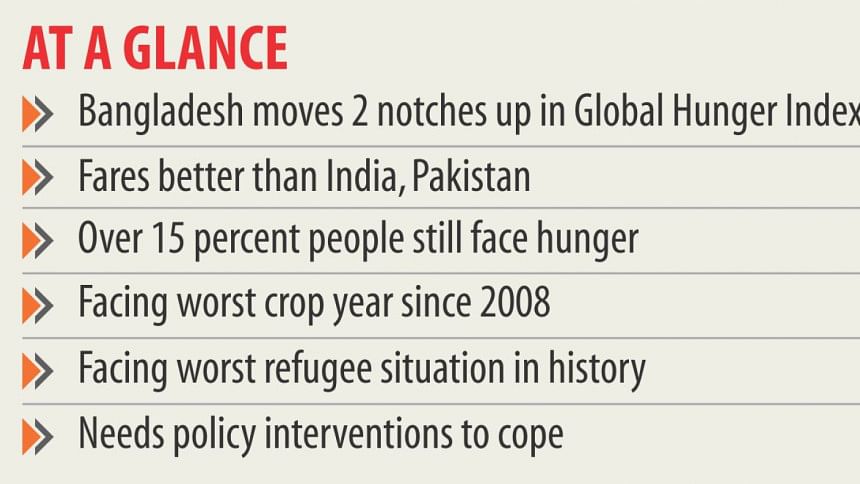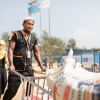Rising from dire straits

Bangladesh has not had a food year so bad since 2008. That was a year now well marked in history books as the year of global economic meltdown, the worst since the Great Depression in the 1930s.
In 2007-08, Bangladesh had a bad crop year, and some of its neighbours were jittery about providing any support.
This year's World Food Day observation today comes as a watershed, with Bangladesh sourcing food grains from every possible country, including Myanmar, to offset a record domestic production shortfall.
All of this comes into play when the country has to play host to one of history's largest refugee populations amid an ethnic cleansing taking place in its backyard.
Dr Sue Lautze, who represents the United Nations Food and Agriculture Organisation (FAO) in Bangladesh, reckons Bangladesh is in "dire straits".
"Rice import has increased significantly. There are macro-economic pressures. Such a huge influx of Rohingyas in a short span of time -- this is really admirable that Bangladesh is tackling this humanitarian crises," Lautze said in all appreciation.
What is heartening yet is Bangladesh's ranking has gone two notches up in this year's Global Hunger Index (GHI), a flagship IFPRI (International Food Policy Research Institute) publication.
The GHI 2017 shows Bangladesh graduated to 88th position from last year's 90th in the 119-country ranking. Its two South Asian neighbours India and Pakistan are trailing at 100th and 106th positions respectively.
In different reports released on the eve of the World Food Day, international organisations such as the FAO and the IFPRI who keep track of global hunger scenario still identified South Asia and some parts of Africa as hunger hotspots.
Given three-quarters of South Asia's population lives in India, the situation in that country strongly influences South Asia's regional score, noted IFPRI.
Rates of stunting, wasting and mortality among under-five-year children are some of the key indicators that are base for IFPRI for doing GHI rankings.
More than a fifth (21 percent) of children in India suffers from wasting. Only three other countries in this year's GHI -- Djibouti, Sri Lanka and South Sudan -- have data or estimates showing child wasting above 20 percent.
Stunted children are short in height for their age, and wasted children are low in weight for their height. These are important public health indicators.
Between early 1990s and 2007, Bangladesh drastically cut the number of its undernourished people (ones who can't afford enough food for healthy living) from an astounding 36.1 percent to 16.4 percent.
But in the subsequent one decade the reduction rate slowed down. As per the GHI 2017, some 15.1 percent of the Bangladeshi population still faces hunger.
Asked to explain the reason of slower hunger reduction, IFPRI country head in Bangladesh Dr Akhter Ahmed told The Daily Star, "The Hunger Index is prepared by taking mortality rate, stunting rate -- all these -- into consideration. But after years of drops in the rate of childhood stunting, it still remains as high as over 36 percent in Bangladesh."
He called for serious policy interventions so that child marriage, adolescence pregnancies are stamped out; otherwise, childhood stunting would not drop further.
On the double challenge of hosting over half a million Rohingyas in a bad crop year, Akhter said, "I don't think the current food shortage and price hike crisis would persist beyond November when farmers would start harvesting Aman paddy. But on the question of Rohingyas, a lot depends on the international community's assistance and food supports and also how soon they're repatriated."
The UN World Food Programme (WFP) has already committed to continue providing food for the Rohyinga refugees beyond February next year.
Dr Lautze said Bangladesh's development partners, who have a Food Security Cluster here and with which both the FAO and the WFP are working as co-leads, are actively pursuing to pool funds for Rohingyas.
Turning to this year's Food Day theme “Change the Future of Migration-Invest in Food Security and Rural Development,” the FAO representative said, "It's good for household food security if people migrate and are able to remit money back home. In fact, migrants' remittance, as source of rural investment, has outpaced the banks."
In a most conservative estimate, farmers in the country lost two million tonnes of rice this year due to flashflood that struck very early into the season in end-March in the northeastern backswamps and also sporadic fungal attacks -- rice blast -- in 19 districts.
In just three months into the 2017-18 financial year, the government and private traders imported over a million tonnes of rice, an eight fold rise already from last fiscal's import.

 For all latest news, follow The Daily Star's Google News channel.
For all latest news, follow The Daily Star's Google News channel. 








Comments